
Alois Friedrich Rogenhofer was an Austrian entomologist. He was a curator at the Naturhistorisches Museum in Vienna, where he was the first keeper of the Lepidoptera. Rogenhofer was mainly interested in Lepidoptera, and Hymenoptera.

Epiphryne verriculata, the cabbage tree moth, is a moth in the family Geometridae. It is found only in New Zealand, and only feeds on the native cabbage tree ; its wings are patterned to camouflage it against dead cabbage tree leaves.
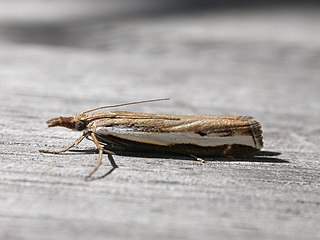
Orocrambus is a genus of moths of the family Crambidae. All species are endemic to New Zealand.
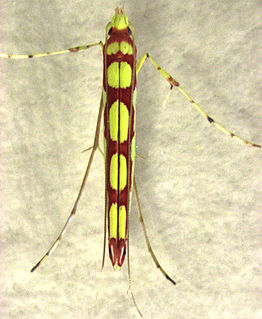
Macarostola miniella is a species of moth in the family Gracillariidae. It is endemic to New Zealand. This species is only found in the North Island and the adult moths have two different colour variations.

Glyphipterix tungella is a species of sedge moth in the genus Glyphipterix. It is endemic to New Zealand.
Prophantis octoguttalis is a species of moth of the family Crambidae. The species was described by Baron Cajetan von Felder, Rudolf Felder and Alois Friedrich Rogenhofer in 1875. It is found on the Maluku Islands in Indonesia.

Epiphryne undosata is a moth of the family Geometridae. It is endemic to New Zealand.
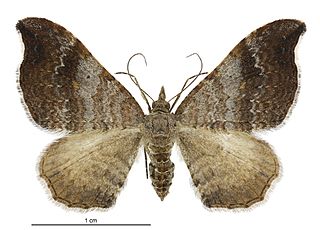
Homodotis megaspilata, also known as the small hooked-tip looper moth, is a moth of the family Geometridae. It is endemic to New Zealand and can be found throughout the country. It is regarded as being common species. The preferred habitat of this species is native forest, scrub, coastal areas and domestic gardens. Larvae feed on the dead leaves of Geniostoma ligustrifolium and likely other native plants. Once mature the larvae will pupate on the ground forming a silken cocoon protected by hiding inside two leaves of its host plant. Adults are nocturnal and are on the wing from October to April. They are attracted to light. In appearance the adults of this species are extremely variable but can be distinguished from similar species as all variations have forewings with blunt hook shaped tips.
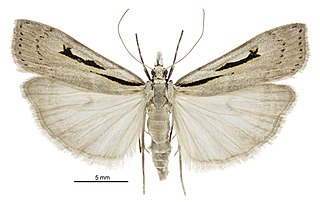
Scoparia rotuella is a species of moth in the family Crambidae. It was described by Cajetan Felder, Rudolf Felder and Alois Friedrich Rogenhofer in 1875 under the name Crambus rotuellus. In 1913 Edward Meyrick revised the taxonomy of the species and placed it within the genus Scopaira. It is endemic to New Zealand. Adults of this species have been shown to pollinate Helichrysum selago and Veronica salicifolia.

Scoparia ustimacula is a species of moth in the family Crambidae. It was described by Cajetan Felder, Rudolf Felder and Alois Friedrich Rogenhofer in 1875. It is endemic to New Zealand.
Glaucocharis interruptus is a moth in the family Crambidae. It was first described by Cajetan von Felder, Rudolf Felder and Alois Friedrich Rogenhofer in 1875 and named Crambus interruptus. It is endemic to New Zealand.
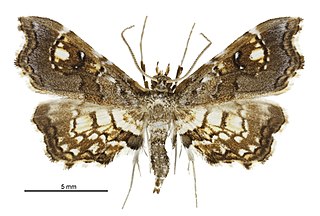
Musotima aduncalis is a moth in the family Crambidae. It was described by Cajetan Felder, Rudolf Felder and Alois Friedrich Rogenhofer in 1875. This species is endemic to New Zealand.
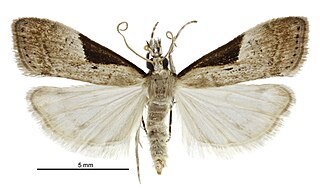
Eudonia pongalis is a moth in the family Crambidae. It was described by Cajetan Felder, Rudolf Felder and Alois Friedrich Rogenhofer in 1875. It is endemic to New Zealand.
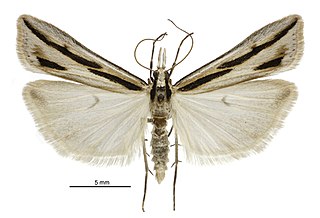
Eudonia trivirgatus is a moth in the family Crambidae. It was first described by Cajetan Felder, Rudolf Felder and Alois Friedrich Rogenhofer in 1875 as Crambus trivirgatus. It is endemic to New Zealand.
Thalamarchella alveola is a moth in the family Depressariidae. It was described by Cajetan Felder, Rudolf Felder and Alois Friedrich Rogenhofer in 1875. It is found in Australia, where it has been recorded from Western Australia.
Atasthalistis tricolor is a moth in the family Gelechiidae. It was described by Cajetan Felder, Rudolf Felder and Alois Friedrich Rogenhofer in 1875. It is found in Indonesia, the Solomon Islands and Australia, where it has been recorded from the Northern Territory.
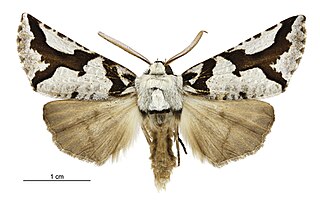
Declana egregia, commonly called the South Island lichen moth or zebra lichen moth, is a moth in the family Geometridae, endemic to New Zealand. This species was first described by entomologists Baron Cajetan von Felder and Alois Friedrich Rogenhofer in 1875 under the name Chlenias egregia.

Asaphodes obarata is a moth in the family Geometridae. It is endemic to New Zealand and has been collected in both the North and South Islands. It seems to inhabit the margins of native forest and also frequents plains with an affinity for gorse hedges. The host plants of the larvae of this species are unknown. The adults are on the wing in December and January. It is classified as critically endangered by the Department of Conservation. There has been a contraction of range of A. obarata with it now being regarded as locally extinct in both Dunedin and Invercargill.
Sorolopha bryana is a moth of the family Tortricidae. The species was first described by Cajetan Felder, Rudolf Felder and Alois Friedrich Rogenhofer in 1875. It is found in Sri Lanka.
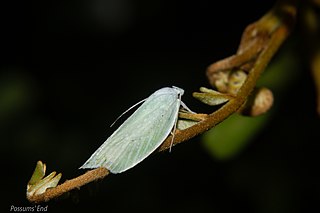
Nymphostola is a monotypic moth genus in the family Oecophoridae or the family Depressariidae. The genus was erected by Edward Meyrick in 1883. Its only species, Nymphostola galactina, the tarata flat moth, was described by Cajetan Felder, Rudolf Felder and Alois Friedrich Rogenhofer in 1875. It is endemic to New Zealand.















